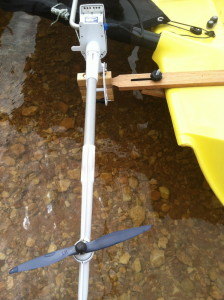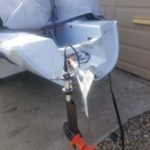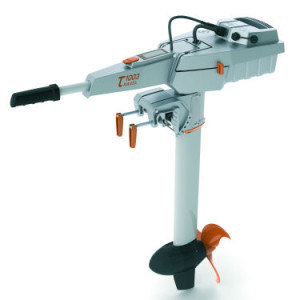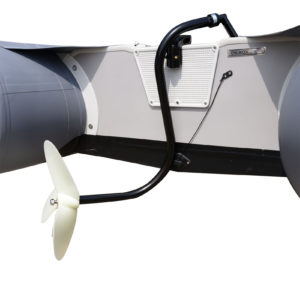Home › Forums › General Weta Stuff › Outboard motors and brackets › Reply To: Outboard motors and brackets
Outboards
Probably the most important aspect of using an outboard on a Weta is the weight of the engine and where it can be distributed to have least impact on your sailing experience. Having extra weight on the stern is slow in light winds but of course you can counter that with your body weight.
Then there’s the issue of stowing the engine when it’s not in use. The below deck storage compartment has benefits in that the weight of the outboard is then in the centre of the boat and near the water line. However the compartment below deck is not very deep so careful measurement of the engine and compartment is recommended before purchase, if you plan to stow it below.
The standard 6″ hatch is too small for any outboard but Kayak hatches offer various shapes and sizes which can be latched shut securely. The hatch in front of the daggerboard must seal closed because the storage compartment below deck provides buoyancy in a capsize – the boat may not be righted if this is compromised.
If you are storing a petrol outboard below deck you may need to carry an additional fire extinguisher above deck, depending on your local marine regulations.
Lying the outboard in the cockpit is an option but it may get in the way when tacking and is liable to catch on ropes.
Engine options include:
1. Electric paddle

The electric paddle is different from a trolling motor in that it’s designed for propelling small boats rather than just moving quietly after fish. It has a brushless electric motor which outputs 30Wats of power, but unlike a trolling motor, it uses a “model aeroplane” type propeller which is much more efficient for continuous propulsion.
One Weta owner reports: “The EP can move the Weta on calm waters with little to no wind in the 2.8 to 3.0 knot range if you have the main and jib up. Bare pole only the speed drops a couple tenths. The apparent wind created by the propulsion of the EP helps generate the additional speed. Throttling back to the mid-range setting drops the speed by .3 kts so not much of penalty, considering the gain in range. I have yet to run the NIMH battery down to empty and would guess that the furthest I have run on a charge if 4 to 5 miles.”
The manufacturer claims the range is as follows
- Almost 2 hours at High speed
(about 2.5-3.5 mph on many small boats) - Up to 4 hours at Medium speed
- Up to 5 hours at Low speed
Weight:
- Motor weighs 7.6 lbs.
- NiMH Battery pack weighs 8.1 lb.
- Smart Charger weighs 1.28 lbs.
Size:
- Motor envelope sizes
Short shaft: 7” dia. x 38.5” long
Long shaft: 7” dia. x 43.5” long
Mini shaft: 7” dia. X 33.5” long - Waterproof battery comes in a floating bag 9” x 7” x 6”.
- Smart Charger fits into a 6” x 8” ditty bag.
Minimum battery range:
- At High Setting, the battery will last almost 2 hours.
- At Medium Setting, the battery will last about 4 hours.
- At Low Setting (midway between off and Medium setting) the battery will last 5 hours.
- Recharge time: about 3 hours.
Speed control:
- High Setting = 100% output
- Medium Setting = 50% output
- Midway below Medium and Off (not marked) = 33% output
2. Electric outboard motor
There’s a useful buyers guide to Electric outboard motors over 5Kw here and under 5Kw here
Sold as a trolling motor for Kayaks ( The 1103 a new more powerful version is now available), the advantage for the Weta is that the drive is separate from the battery and connected by cables. This means you can separate the weight of the battery from the engine which is much better for weight distribution and stowing. Weta owner, Glenn Madere installed the mount following the manufacturer’s diagram for an off-center installation (see p. 47 of the Manual) as if his main hull were a kayak, adjusting the vertical “shaft” as far down as it will go. Between this adjustment and keeping crew weight aft and on the motor side, the prop has enough depth to perform well in up to, say, a foot of chop. The battery is said to be good for 1hr of use.
503 $1699/ 1003 $1999
Revised for 2015 the Torqueedo Travel is sold as a replacement for 1.5 HP (503) and 3HP (1003) Engines but this is a misleading comparison, as a 3hp petrol motor will get many small, lightly loaded craft of the right hull form “on the plane”, and a Torqeedo 1003 won’t. The propeller supplied is not even designed for that sort of speed (it’s rated 9kmph at 790W, or about 6 knots flat out). Where the Torqeedo excels is pushing surprisingly heavy loads (when the 3hp petrol wouldn’t get you on the plane anyway) at up-to-displacement speeds. 4 or 5 knots in a typical 9ft inflatable dinghy, for example.
The acceleration up to those speeds is also impressive, as electric motors (unlike petrol ones) generate full torque from very low revs – there is never a “lag” after twisting the throttle. So the Torqeedo 1003 has lots of low to mid-range push, but not the whizzy top end of a petrol. Unlike “trolling motors” it will be genuinely useful as a main propulsion unit – just not for anything much over 6 knots (12kmph).
- On-board computer with GPS-based calculation of remaining range
- Removable battery and tiller
- Solar rechargeable – including during the voyage
- Stepless forward/reverse drive
- Completely waterproof (IP 67)
- Integrated battery with 320 Wh Li-Ion
- Max speed 9-10 km/h (depending on type of boat, wind and waves)
- Charging time: 7 hrs
- Remote throttle available
| Speed in knots (km/h) | Range in sm (km) | Running time in hours | |
|---|---|---|---|
| Slow | 2.0 (3.7) | 12.8 (23.7) | 06:20 |
| Half throttle | 3.0 (5.5) | 6.4 (11.9) | 02:08 |
| Full throttle | 4.0 (7.4) | 2.8 (5.2) | 00:42 |
| Torqueedo Travel Model Comparison | 503 | 1003 |
| Input power in watts: | 500 | 1,000 |
| Propulsive power in watts: | 220 | 480 |
| Maximum overall efficiency in %: | 44 | 48 |
| Static thrust in kg / lbs*: | 40 | 68 |
| Integrated Li-Ion battery in Wh: | 320 | 530 |
| Nominal voltage in V: | 29.6 | 29.6 |
| Final charging voltage in V: | 33.6 | 33.6 |
| Total weight in kg / lbs: | 12.9kg / 28.4lbs | 13.4kg / 24.6lbs |
| Motor weight without battery in kg / lbs: | 8.9kg / 19.6lbs | 8.9kg / 19.6lbs |
| Weight of integrated battery in kg / lbs: | 4.0kg / 8.8lbs | 4.5kg / 9.9lbs |
| Shaft Length: | 62.5cm / 24.6in | 62.5cm/ 24.6in |
| Standard propeller (v = speed in km/h at p = power in watts): | v9/p790 | v9/p791 |
| Maximum propeller speed in rpm: | 700 | 1,200 |
| Stepless forward/reverse drive: | Yes | Yes |
| Integrated on-board computer with display: | Yes | Yes |
ePropulsion Spirit 1.0
$1930 approx (HQ in Hong Kong, Distributors worldwide)
New Spirit 1.0 Evo is a portable 3HP electric outboard made for dinghies, fishing boats, and sailboats. It features a 1276Wh large integrated lithium battery for long range. The hydrogeneration function recharges the battery while sailing.
ePropulsion Spirit 1.0 Evo web page
- kW: 1.0 • Voltage: 40.7 (nominal) • HP: 3
- Battery: Integrated • 1.02 kWh • LiPo (lithium-ion-polymer)
- Running Time: 1 hrs – 4 hrs
- Shaft Length (cm): (XS): 52.5 • (S): 62.5 • (L): 75
- Weight (kg): Motor: 11 • Battery: 8.8 (varies with shaft length and/or tiller)
- Steering: Tiller or Remote, Wireless
- Other: Hyrdrogeneration. Two year limited warranty. As of May 2019 wireless remote control is available
- Country of Manufacture: China
- Price: €1800 – €2136 • $2150 – $2400
ePropulsion Navy 3.0 Evo web page
- kW: 3.0 • Voltage: 46.8 (nominal) • HP: 6
- Battery: Non-Integrated • 3.04 kWh • Li-ion
- Running Time: 1 hrs – 4 hrs
- Shaft Length (cm): (S): 64 • (L): 76.5
- Weight (kg): Motor: 24 • Battery: 31.5 (varies with shaft length and/or tiller)
- Steering: Tiller or Remote, Wireless
- Other: Hydrogeneration. Two year limited warranty, one year on battery. Wide variety of accessories available.
- Country of Manufacture: China
- Price: €2500-€2600 • $2900 – $3050
3. Petrol (4-stroke) motor
$500 approx
The Thai-made Super Chibi uses a reliable 1HP Honda Engine (designed for garden tools) mated to a short drive-shaft and neat integrated petrol tank.
I have seen one used on a Laser (!) which had to sail to yacht racing regulations
| Engine | Honda GX 25 |
| Maximum Power | 1.0 HP. @ 7,000 RPM. |
| Dimensions | L660mm x W210mm |
| Cooling System | Air |
| Driving system | Direct Shaft system ,no Clutch |
| Gear ratio | 1:2 |
| Displacement Tonnage | ~ 200 Kg. |
| Propellor | 3 Blade made from Nylon -66 Resin |
| Fuel tank Capacity | 600 cc. |
| Weight | 5.5 Kg. (Not including installation set) |
| Consumption Rate | ~ 400 CC./Hr. |
| Performance | Maximum speed 10 Kmh /5.3 knots (depending on load, wind, waves) |
| Operation | ~ 90 Min |
4. Propane Outboard
Price $1000 appprox
The US-made Lehr runs on propane and the cannisters can add to the overall weight.
| Engine Type | Propane-Powered 4 Stroke OHV |
| Horsepower Rating | 2.5 hp (1.8 kW) |
| Displacement | 4.39 cu in / 72 cc |
| Bore X Stroke | 2.12″ x 1.37″ / 54mm x 31.5mm |
| Cylinders | 1 |
| Full Throttle RPM Range | 4500-5500 RPM |
| Ignition System | CDI Ignition |
| Starting System | Manual |
| Fuel | Propane (110 Octane) |
| Carburetion | No Choke / No Priming |
| Lubrication | Wet Sump |
| Control System | Tiller Handle |
| Trim Positions | 5 |
| Gear Shift | F-N |
| Gear Ratio | 2.08 |
| Shaft Length | 15″ |
| Standard Prop | 7.25″ x 6″ 3 Blade Aluminium |
| Weight | 37.4 lbs / 16.96 kg |
| Fuel Tank Type | |
| On Board | Twist ‘n Go 16.4 oz Propane Canister |
| Remote (Optional) | 11 & 17 lb Composite Tanks |
| Recommended Oil | 4 Stroke 10W-30 |
| Engine Oil Capacity | 0.37 US qt (0.35L) |
| Warranty | 3 Year Limited Warranty |
| C.A.R.B. Rating | 3 Star Ultra Low |
| Range | 16.4 oz Camping Bottle – @3000RPM – 2.5 hrs, @5000RPM – 1 hr |
5. Weed-wacker conversion
Some people realised you could get a crude but effective “outboard” by putting a propeller on the end of a string trimmer (aka “weed-whip”, “whipper-snipper”, “weed-whacker”, “weed eater”, “strimmer”).
There’s now a few conversion kits available that come as a complete unit or you can DIY with a donor unit
Small Outboard Motor – 1.2 HP
Cost: $250 with a 2-Cycle Motor and $325 with a 4-Cycle Motor
Conversion Kit – for those who want to do-it-yourself: $100.
The Kit does not include the weedeater, which can be purchased from your local hardware store. Fabricated from a Straight Shaft – attachment capable (Split Shaft) Weed Eater. Both 2 cycle and 4 cycle units are available.
Performance: Weight 13.2 lbs
Speed: Tested with a two person Kayak, West Marine’s Water Tender 9.4, Walker Bay, and a Sevylor Fish Hunter. They all ran between 4.0 to 5.5 Knots loaded with one 165 lbs person, swinger ice chest with 6 pack, fishing pole, tackle box, and oars
6. Hand Cranked Outboard.
Originally developed in the 60s, they are now being produced in China and offer a low-tech, quiet propulsion solution – although perhaps oars or a paddle might give you a more efficient method of propulsion for long periods. It might also make be suitable for conversion to power from an electric drill.
Available in UK (£125.00) Germany (EUR 149), Australia (AU$169) under the Freewheeling brand and the USA ($112) as Bris.
The bracket does look a bit flimsy and there’s no hinge to allow it to kick up if you hit anything.
In the video below, it shows how flimsy then turning handle is but also how you can improve it substantially with an electric drill. Another video testing the speed and battery life here.
Conclusion
From the options above, you can see that the petrol outboard has the best power to weight ratio and highest top speed – although there are all the issues of pollution, noise and transporting a flammable liquid.
The electric motors may not have the top speed of a petrol or propane motor so they won’t get you planing – but they produce thrust at very low speeds and can output a steady power for reasonably long periods. The electric motors can be disassembled allowing you to stow components below deck and some can separate the battery entirely from the drive unit using cables for better weight distribution.
-
This reply was modified 2 years, 8 months ago by
Paul White.
-
This reply was modified 2 years, 8 months ago by
Paul White.
-
This reply was modified 2 years, 8 months ago by
Paul White.
-
This reply was modified 2 years, 2 months ago by
Paul White.
-
This reply was modified 2 years, 2 months ago by
Paul White.
















